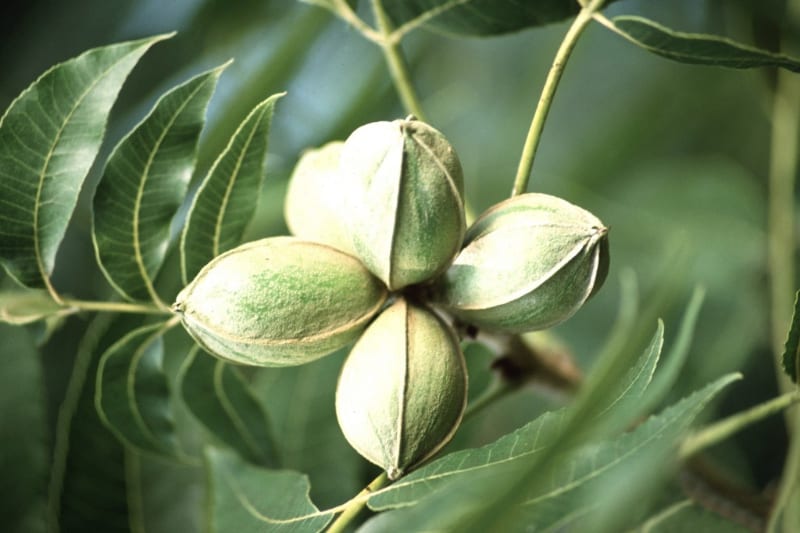Pecan (Carya Illinoensis) is the best-known of all the Hickories. It can be recognized by thier alternate, pinnately compound leaves with 9 to 15 finely serrate leaflets, 12 to 18 inches long.
The nuts are large oblong, brown, splotched with black, thin-shelled nuts, 1 1/2 to 2 inches long. Nuts are in clusters on trees. Fruits mature in September and October.
The bark is smooth when young but becomes narrowly fissured into thin broken strips, sometimes scaly.

Pecan Tree Features
- Scientific Name: Carya illinoinensis
- Family: Juglandaceae
- Type: Deciduous tree
- Height: Can grow between 70 to 100 feet, with some trees reaching up to 150 feet
- Spread: Up to 75 feet
- Lifespan: Can live for over 300 years
- Native Range: Southern United States, particularly in areas like Texas and Georgia
- USDA Hardiness Zones: 6-9
- Preferred Conditions: Full sun exposure and well-drained, deep soils with a pH of 6.0 to 7.0. They do not tolerate waterlogged conditions.
- Fruit: A nut, which is technically a drupe. Trees begin producing nuts at around 12 years of age, with peak production occurring every other year
Additional Facts
- State Tree: It has been the state tree of Texas since 1919.
- Economic Importance: Represents a significant agricultural product in states like Georgia, which is known as the pecan capital of the US
- Uses: Apart from their edible nuts, wood is valuable for making furniture and flooring. The nuts are a popular ingredient in various dishes and are celebrated in cultural events like National Pecan Day and National Pecan Pie Day
- One of the few nuts native to North America, with a history deeply intertwined with Native American culture. They were also used to make plant-based milk and a fermented beverage
- The name “pecan” comes from the Algonquin word “Pacane,” meaning nuts requiring a stone to crack due to their hard shells
How to Plant, Grow, and Care for Pecan Trees?
- Time: Plant pecan trees in late winter or early spring when they are still dormant to reduce transplant shock
- Location: Select a site with full sun (at least 8 hours daily) and well-drained, deep soil. Avoid areas where water collects, as pecan trees do not tolerate permanently wet feet
- Pruning: Prune young trees in late winter to develop a strong framework, aiming for a central leader with four to six lateral branches. Cut back the top third of the branches each year for the first five years. Mature trees require minimal pruning
- Care: Monitor for common pests such as pecan weevils and aphids. Use proper pesticides if necessary.
- Soil pH: Ensure the soil pH is between 6.0 and 7.0
- Protection: Use chicken wire to protect young trees from rabbits and deer
- Longevity: Pecan trees can live for more than 300 years, so they are a long-term investment
Uses of Pecan Tree Nuts
Often consumed raw or roasted as a healthy snack. They are rich in healthy fats, proteins, and essential nutrients, making them a popular choice for a nutritious bite.
They are widely used in baking, particularly in traditional Southern recipes like pecan pie, pralines, and pecan cookies. Adding these nuts will provide a crunchy texture to pastries and cakes.
You can even use it in salads or as a side with fish and other meat.
Pecan nuts can be ground into creamy nut butter, which can be used as a spread on toast, mixed into smoothies, or used as a base for sauces and dressings.
Another great option is plant-based milk, a perfect dairy-free alternative, which is made by blending the nuts with water and straining the mixture. The oil, extracted from the nuts, is used in cooking and dressings due to its mild, nutty flavor.
Nutritional Benefits
These nuts are packed with essential vitamins and minerals, including vitamin E, magnesium, zinc, and fiber. They are also a good source of antioxidants, which help reduce inflammation and support heart health.
They also contain high levels of monounsaturated fats, which are beneficial for maintaining healthy cholesterol levels and reducing the risk of heart disease.
Last Words
The pecan tree is an important part of agriculture in North America. For generations, families have planted and cared for pecan trees to harvest the nuts.
They require work to grow but produce rewards. Pecans are both eaten as a nutritious snack and used commercially. The trees thus have significance in both nutrition and the economy.

